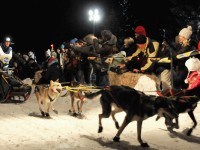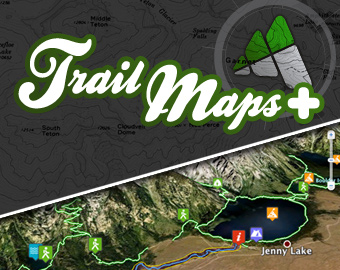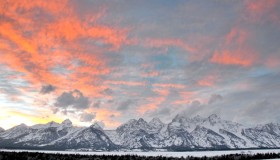Wildflowers in the Teton Region
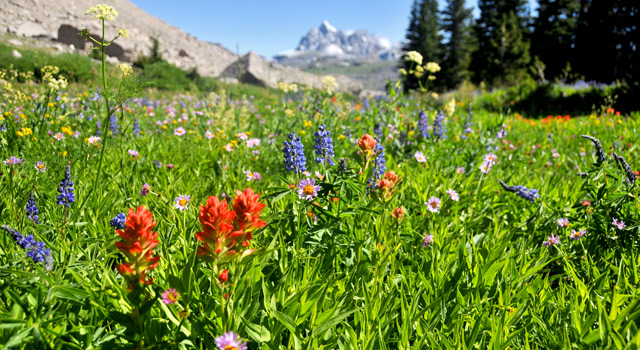
With only 60 to 70 frost free days a year, wildflowers take advantage of every summer moment. The lower elevations witnessed flora fauna blossom with vibrant color. As the weeks go by and the snow line continues to recede, vegetation will rise through the canyons and up mountain sides reaching all the way to the Teton crest.
Habitat Zones
Grand Teton National Park and the surrounding region can be separated into three distinct vegetation zones: the sagebrush valley, the forest floor, and the alpine zone.
The Sagebrush Valley
Skyrocket gilia, larkspur, and indian paintbrush bloom in the valley as temperatures rise. Porous valley soils support plants that are stubborn enough to tolerate hot and dry conditions. Visible throughout the region, these flowers paint the countryside with color.
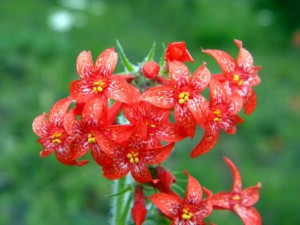
Skyrocket gilia: It has characteristic red, trumpet-shaped flowers and basal leaves stemming from a single erect stem. There are many subspecies. It is also called honeysuckle, owing to the shape of the flower and the droplet of nectar that can be enjoyed by picking off the flower and sucking it out of the basal end.
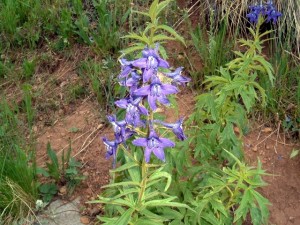
Larkspur: The leaves are deeply lobed with 3-7 toothed, pointed lobes in a palmate shape. The main flowering stem is erect, and varies greatly in size between the species, from 10 centimeters in some alpine species, up to 2 meters tall in the larger meadowland species; it is topped with a raceme of many flowers, varying in color from purple and blue to red, yellow or white.
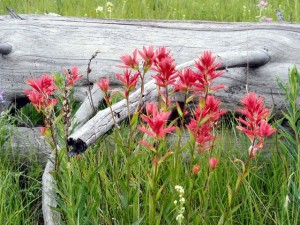
Indian Paintbrush is the state flower of Wyoming. The flowers of Indian paintbrush are edible and sweet, and were consumed in moderation by various Native American tribes as a condiment with other fresh greens. Indian paintbrush has similar health benefits to consuming garlic if only the flowers are eaten in small amounts and in moderation.
The Forest Floor
Flowers like fireweed, columbine, monkshood, and the rare calypso orchid enjoy the moist environments found in forests. As elevation increases, wildflowers spread across the the slopes of mountains trees become stunted and eventually shrublike.
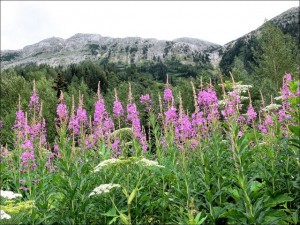
Fireweed: This herb is often abundant in open fields, pastures, and particularly burned-over lands; the name Fireweed derives from the species’ abundance as a coloniser on burnt sites after forest fires. Its tendency to quickly colonize open areas with little competition makes it a clear example of a pioneer species.
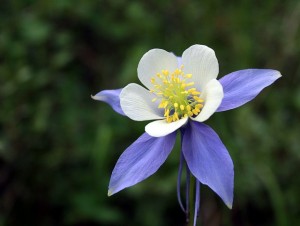
Columbine is a wildflower native to mountain meadows, open woods, and alpine slopes of the Rocky Mountains from Utah north to British Columbia and Alberta.
The plant grows to up to 3 feet in height. While the most common flower color is yellow, portions of the flowers can also be blue, yellow-pink, raspberry pink, white, and cream.
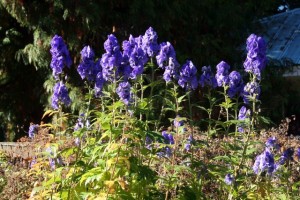
Monkshood: These perennial plants are chiefly natives of the mountainous parts of the northern hemisphere, growing in moisture retentive but well draining soils on mountain meadows.They are distinguishable by having one of the five petaloid sepals (the posterior one), called the galea, in the form of a cylindrical helmet; hence the English name monkshood.
The Alpine Zone
The flowers of the alpine zone grow close to the ground and the flowers are very small. The extremely short season, and extreme conditions make these plants very delicate. Examples include moss campion, alpine forget-me-not, and sky pilot.
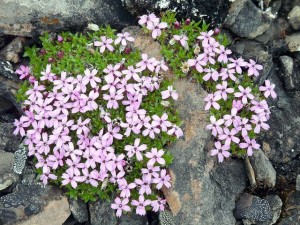
Moss Campion is a small mountain-dwelling wildflower that is common all over the high arctic and the higher mountains of North America. It is densely tufted, forming domed cushions composed of long shoots with four or five small green leaves at their apex and many remnants of old leaves below.
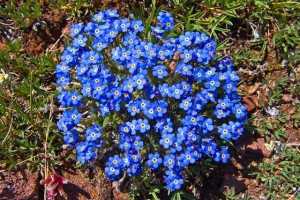
Alpine forget-me-not is Alaska’s state flower. In Wyoming, the wild Alpine forget-me-not grows well in open, rocky places high in the mountains. You will see the diminutive alpine forget-me-not in midsummer. Alpine Forget-me-nots belong to one of the few plant families that display true blue flowers.
Flower descriptions were provided in part by Wikipedia. Enjoy the wildflower season in Grand Teton National Park and the surrounding National Forests this summer!
Tweet
!function(d,s,id){var js,fjs=d.getElementsByTagName(s);if(!d.getElementById(id)){js=d.createElement(s);js.id=id;js.src="//platform.twitter.com/widgets.js";fjs.parentNode.insertBefore(js,fjs);}}(document,"script","twitter-wjs");
The 43rd Annual Shriner's Cutter Races
Previewed By: Adam Glos
Saturday, February 15th // Sunday, February 16th
Melody Ranch // Jackson, WY
12:00 pm – 3:00 pm
General Admission: $15
This weekend, give your ski legs a break and make your way down to Melody Ranch for the 43rd Annual Cutter Races. Sponsored by the Jackson Hole Shrine Club and ...
Read More
Tweet
!function(d,s,id){var js,fjs=d.getElementsByTagName(s);if(!d.getElementById(id)){js=d.createElement(s);js.id=id;js.src="//platform.twitter.com/widgets.js";fjs.parentNode.insertBefore(js,fjs);}}(document,"script","twitter-wjs");
The 2014 Banff Mountain Film Festival World Tour
Sponsored By: Skinny Skis
Previewed By: Adam Glos
Saturday, Feb. 8th / 8 pm // Sunday, Feb 9th / 7 pm
Jackson Hole High School Auditorium
Tickets: $12 each night / $20 for both nights
Every year in November, thousands of outdoor enthusiasts descend upon the little town of Banff nestled deep ...
Read More
Tweet
!function(d,s,id){var js,fjs=d.getElementsByTagName(s);if(!d.getElementById(id)){js=d.createElement(s);js.id=id;js.src="//platform.twitter.com/widgets.js";fjs.parentNode.insertBefore(js,fjs);}}(document,"script","twitter-wjs");
2014 Coldsmoke Awards
Previewed By: Stephen Williams
Saturday January, 18th
Emerson Cultural Center, Bozeman MT
North of the Sun - Filmhuset AS
Never Not Part 2 - Nike
Valhalla - Sweetgrass Productions
Previous Photos
Read More
Avalanche Awareness Night
Thursday 12/05 - 6:30 to 9:30pm
Jackson Hole Center for the Arts
$5 Donation benefits Teton County Search and Rescue
Previewed by: Stephen Williams
From the time that Powder Magazine's annual Buyer's Guide arrives in the mail in the late summer, the countdown to the upcoming winter season begins. Living in Jackson over the last few years, ...
Read More
Tweet
!function(d,s,id){var js,fjs=d.getElementsByTagName(s);if(!d.getElementById(id)){js=d.createElement(s);js.id=id;js.src="//platform.twitter.com/widgets.js";fjs.parentNode.insertBefore(js,fjs);}}(document,"script","twitter-wjs");
03/10/14 - 2nd Annual Ski Joring Championships
Written and Photographed By: Stephen Williams
Ski Joring is an event with a perfect mix of Jackson Hole's historic cowboy culture and the new ski bum lifestyle. Presented by the Shriner's Club as a part of Jackson hole Winterfest, the skier lassos up the horse and rider and hangs ...
Read More
Tweet
!function(d,s,id){var js,fjs=d.getElementsByTagName(s);if(!d.getElementById(id)){js=d.createElement(s);js.id=id;js.src="//platform.twitter.com/widgets.js";fjs.parentNode.insertBefore(js,fjs);}}(document,"script","twitter-wjs");
Canyon Kids Release Double EP
Written By: Adam Glos
Photos by: Christie Quinn
In case you missed it, the debut album from Canyon Kids hit the electronic shelves recently, proving once again that the small town of Jackson has some serious talent up its sleeves.
Canyon Kids is a musical byproduct and collaboration spearheaded by local musicians Dusty ...
Read More
Tweet
!function(d,s,id){var js,fjs=d.getElementsByTagName(s);if(!d.getElementById(id)){js=d.createElement(s);js.id=id;js.src="//platform.twitter.com/widgets.js";fjs.parentNode.insertBefore(js,fjs);}}(document,"script","twitter-wjs");
<
Head for the Hills
Previewed By: Ellie Stratton-Brook
Thursday March, 6th
Town Square Tavern // Jackson, WY
9:00pm // Tickets: $10 // Buy Tickets Online
Although you may have seen many bluegrass bands around these parts, Head for the Hills maintains a unique sound that combines a jam band attitude with catchy lyrics and sophisticated tunes. Hailing from Colorado, ...
Read More
Tweet
!function(d,s,id){var js,fjs=d.getElementsByTagName(s);if(!d.getElementById(id)){js=d.createElement(s);js.id=id;js.src="//platform.twitter.com/widgets.js";fjs.parentNode.insertBefore(js,fjs);}}(document,"script","twitter-wjs");
02/23/24 - A skier flies off a jump being pulled behind a horse racing down a track at Melody Ranch just south of Jackson for the 2nd Annual Ski Joring. Photographer: Stephen Williams
Previous Photos
Read More
Tweet
!function(d,s,id){var js,fjs=d.getElementsByTagName(s);if(!d.getElementById(id)){js=d.createElement(s);js.id=id;js.src="//platform.twitter.com/widgets.js";fjs.parentNode.insertBefore(js,fjs);}}(document,"script","twitter-wjs");
The 2nd Annual North American Skijoring Championships
Previewed By: Adam Glos
Saturday, February 22nd - 12:00pm
1 Sunday, February 23rd - 11:00am
Melody Ranch // Jackson, WY
General Admission: $10 // Kids 12 and Under: FREE
If you found yourself having oodles of fun at last week’s Cutter Races, then you’re sure to be entertained by the JH Shrine Club’s ...
Read More
Tweet
!function(d,s,id){var js,fjs=d.getElementsByTagName(s);if(!d.getElementById(id)){js=d.createElement(s);js.id=id;js.src="//platform.twitter.com/widgets.js";fjs.parentNode.insertBefore(js,fjs);}}(document,"script","twitter-wjs");
The 2014 KHOL 89.1fm Winter Membership Drive
Previewed By: John Leonard
February 11th - February 17th
Call 307.733.5465 to Donate
Visit www.891khol.org
Member Appreciation Party w/ El Ten Eleven
Live at the Center for the Arts
Sunday February, 23rd
The voice of Jackson Hole, 89.1 KHOL, is kicking off their 2014 Winter Membership Drive February 11th-17th. The listener supported station is coming ...
Read More
Tweet
!function(d,s,id){var js,fjs=d.getElementsByTagName(s);if(!d.getElementById(id)){js=d.createElement(s);js.id=id;js.src="//platform.twitter.com/widgets.js";fjs.parentNode.insertBefore(js,fjs);}}(document,"script","twitter-wjs");
Infamous Stringdusters
Tuesday February, 11th
Mangy Moose // Teton Village, WY
9:00pm // Tickets: $20
Sweethogs and Swinehearts Ball with Infamous Stringdusters
Previewed By: Matt Herron
Wednesday February, 12th
Mangy Moose // Teton Village, WY
9:00pm // Tickets: $25
Before making reservations at McDonald’s or buying Dollar Store chocolates for Valentine’s Day, dirtbags of Jackson get to do something sweet for themselves at ...
Read More
Tweet
!function(d,s,id){var js,fjs=d.getElementsByTagName(s);if(!d.getElementById(id)){js=d.createElement(s);js.id=id;js.src="//platform.twitter.com/widgets.js";fjs.parentNode.insertBefore(js,fjs);}}(document,"script","twitter-wjs");
International Pedigree Stage Stop Sled Dog Race
Previewed By: Kori Price
Race Kick Off
Friday January, 31st
Town Square // 6:30pm
Fireworks and Torchlight Parade
Snow King Resort // 8:00pm
If you haven't already noticed the dog sled signs on every street corner in East Jackson, get ready for the truckloads of snow that's about to be hauled in to make ...
Read More
Tweet
!function(d,s,id){var js,fjs=d.getElementsByTagName(s);if(!d.getElementById(id)){js=d.createElement(s);js.id=id;js.src="//platform.twitter.com/widgets.js";fjs.parentNode.insertBefore(js,fjs);}}(document,"script","twitter-wjs");
Drop IN: Bloody Couloir
Do What You Love
Previewed By: Adam Glos
Tuesday January, 28th
Pink Garter Theatre // Jackson, WY
7:00 pm // Q&A with Jeremy Mcghee to Follow
$10 Suggested Donation // 25% of Proceeds Benefit Teton Adaptive Sports
Every so often, we catch of glimpse of inspiring moments that fill us with a sense of urge to get ...
Read More
Tweet
!function(d,s,id){var js,fjs=d.getElementsByTagName(s);if(!d.getElementById(id)){js=d.createElement(s);js.id=id;js.src="//platform.twitter.com/widgets.js";fjs.parentNode.insertBefore(js,fjs);}}(document,"script","twitter-wjs");
Last of the First Skiers
Presented by Mark Jenkins
Previewed By: Lindley Rust
Thursday January, 23rd
Center for the Arts // Jackson, WY
6:00 pm // FREE
For most of us living in Jackson, WY skiing is a sport, not a means of hunting and gathering for our livelihood. For the tribal people deep in the Altai Mountains of Central ...
Read More
Tweet
!function(d,s,id){var js,fjs=d.getElementsByTagName(s);if(!d.getElementById(id)){js=d.createElement(s);js.id=id;js.src="//platform.twitter.com/widgets.js";fjs.parentNode.insertBefore(js,fjs);}}(document,"script","twitter-wjs");
01/22/14 - The 2014 Coldsmoke Awards
Written By: Ellie Stratton-Brook
Photography By: Stephen Williams
Have you ever been asked why you choose to live in a town where the temperature rarely rises above 20 degrees for a full six months? Typically the answer is universal. The pull of winter sports and exploration in these gorgeous mountains is ...
Read More
Tweet
!function(d,s,id){var js,fjs=d.getElementsByTagName(s);if(!d.getElementById(id)){js=d.createElement(s);js.id=id;js.src="//platform.twitter.com/widgets.js";fjs.parentNode.insertBefore(js,fjs);}}(document,"script","twitter-wjs");
2013/2014 Backcountry Film Festival
Previewed By: Matt Herron
Saturday January, 11th
Pink Garter Theatre
5:30 (All-Ages) / 8:00pm (21+)
$10 (Kids 12 and under are FREE) / Buy Tickets Online
This Saturday January 11, the Wyoming Wilderness Association in partnership with the Winter Wildlands Alliance will be hosting the 9th annual Backcountry Film Festival at the Pink Garter Theater. As ...
Read More
Tweet
!function(d,s,id){var js,fjs=d.getElementsByTagName(s);if(!d.getElementById(id)){js=d.createElement(s);js.id=id;js.src="//platform.twitter.com/widgets.js";fjs.parentNode.insertBefore(js,fjs);}}(document,"script","twitter-wjs");
01/05/14 - Ira Glass speaking Saturday evening at the Center for the Arts. Ira's intriguing and humorous discussion focused on the history and production process of NPR's This American Life, a radio show devoted to creative story telling and thought-provoking narratives. Photographer: Adam Glos
Previous Photos
Read More
Tweet
!function(d,s,id){var js,fjs=d.getElementsByTagName(s);if(!d.getElementById(id)){js=d.createElement(s);js.id=id;js.src="//platform.twitter.com/widgets.js";fjs.parentNode.insertBefore(js,fjs);}}(document,"script","twitter-wjs");
Reinventing Radio: An Evening with Ira Glass
Previewed By: Lindley Rust
Saturday January, 4th
Center for the Arts
5:00pm & 8:00pm (Both Shows are Sold Out)
*Call the Center Box Office to put your name on the wait list. 307-733-4900
Whether you immediately recognize his name, or just know you’ve “heard it somewhere” you can most likely recall the ...
Read More
Tweet
!function(d,s,id){var js,fjs=d.getElementsByTagName(s);if(!d.getElementById(id)){js=d.createElement(s);js.id=id;js.src="//platform.twitter.com/widgets.js";fjs.parentNode.insertBefore(js,fjs);}}(document,"script","twitter-wjs");
Written By: Lindley Rust
The time has come to shred pow, jam good tunes, drink beer, ring in the new year, and make some resolutions that are sure to last two weeks. Whether you’re spending the evening in Jackson, Teton Village, or Wydaho, you shouldn’t have any trouble in finding a good time! There are ...
Read More
Tweet
!function(d,s,id){var js,fjs=d.getElementsByTagName(s);if(!d.getElementById(id)){js=d.createElement(s);js.id=id;js.src="//platform.twitter.com/widgets.js";fjs.parentNode.insertBefore(js,fjs);}}(document,"script","twitter-wjs");
Asleep at the Wheel
Previewed By: Matt Herron
Sunday December, 30th
Pink Garter Theatre
8:30pm / $35 / Buy Tickets Online
What makes Jackson’s music scene great these days is the diversity coming through our venues and bars. Mountain towns will always have a fair share of great reggae and jam-band acts passing through their snowy streets but it ...
Read More





















